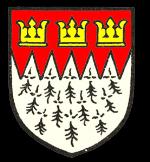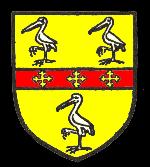Biscot Manor
The Victoria County History for Bedfordshire of 1908 suggested the Biscot Manor can be traced back to a charter of King Offa of Mercia of 792 in which he granted land of five tenants in Luton to Saint Albans Abbey. Charters purporting to be from Anglo-Saxon kings granting land to religious houses are notorious as often being later forgeries by the houses themselves to prove their own title.
After the Norman Conquest of England in 1066 the usurping King, William I, also called William the Bastard and William the Conqueror gradually set about taking away land from indigenous nobles (earls and thegns) and giving it to his own followers. Towards the end of his reign, winter of 1085, whilst at Gloucester, he ordered a complete survey of his kingdom to determine who held each piece of land. This survey became known as the Domesday Book and was carried out in just one year, 1086, a very impressive piece of logistical planning.
Overlords
The Domesday Book records a manor in Biscot comprising five hides (equated with the land of the five tenants of 792). The manor included ten villagers and three slaves - thirteen households, in other words, suggesting a population of a little over fifty. The value of the manor was forty shillings and Ralph Tallboys had transferred it to the royal manor of Luton. Before the conquest in 1066 it had been worth sixty shillings and had been held by Edwin "Asgar the Constable's man".
The King remained overlord until 1115, when King Henry I (1100 to 1135) gave it to Saint Albans Abbey to mark its restoration as an abbey church. This land continued to be held from the abbey as overlord in the same way as the Manor of Dallow. Following the dissolution of the religious houses by King Henry VIII (1509 to 1547) Biscot became held of the Manor of Dallow, the last mention of an overlordship being in 1644.
Tenants
During the reign of King John (1199 to 1216) The Abbey of Saint Albans granted its land in Biscot to Robert Fitz Walter. He was outlawed twice, in 1212 and 1216 and the tenancy of the manor is not recorded again until 1289 when it was held by Hugh de Philibert who granted it to William de Bereford in that year
William de Bereford died in 1327 having an annual quitrent of £9/9/4 from eleven freeholders in Biscot. His son Edmund succeeded him and in 1386 Edmund's son Baldwin de Bereford held the manor, settling it on the heirs of his three aunts in 1401. Baldwin's widow Elizabeth held the manor until her death in 1419 when it passed to Ralph Bush, who conveyed it almost immediately to William Acworth.

Acworth coat of arms
In 1500 John Acworth held the Manor of Biscot as tenant. He was succeeded by his son George and at his death in 1531 his son, another George succeeded. George junior sold the manor in 1549 to John Dormer of London, who transferred it to another London merchant, William Harper, the next year. In 1555 Harper sold the tenancy of the manor to John Alley, whose son mortgaged it to Edward Wingate in 1593.

Wingate coat of arms
Wingate became owner two years later when Francis Alley defaulted on the mortgage. Edward Wingate's son George inherited the manor in 1598 and, on George's death in 1606 his grandson John Wingate inherited. John Wingate died in 1644 and was succeeded by his son Francis who held the manor in 1678. By 1718 the manor had passed to an Arthur Wingate and in 1724 he sold it to John Crawley for £8,796/14/-. The manor remained in the Crawley family into the 20th century. However, a succession of Law of Property Acts in the 1920s effectively abolished manors in all but name. including copyhold land and manorial courts and income.

Crawley coat of arms